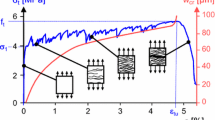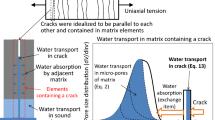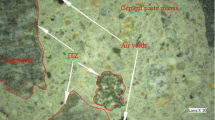Abstract
This paper investigates the correlation between the geometry of crack networks and the altered transport properties of cement-based porous materials. Cracks were artificially introduced into slice specimens to obtain bidimensional (2D) crack networks, and the network was characterized by the crack density, orientation, connectivity and crack opening aperture. For the permeability, the water vapor sorption isotherms were measured and an algorithm was established to solve the intrinsic permeability of cracked specimens with the help of moisture transport modeling and the data of drying tests. The electrical conductivity of cracked specimens was measured using an alternative current method. The study on the specimens with percolated cracks shows that: (1) the pertinent geometry parameters for altered transport properties include average-based crack density, crack opening and local crack connectivity; (2) the water permeability of cracked specimens is correlated to the combination \(b^{1.7}\rho f\) and electrical conductivity to \(b^{0.45}\rho f\); (3) the different exponents on the crack opening/length ratio reflect the resistance of tortuosity of crack paths to the water and current flow and this resistance is stronger for current flow.

















Similar content being viewed by others
References
Adler, P.M., Thovert, J.-F., Mourzenko, V.V.: Fractured Porous Media. Oxford University Press, London (2012)
Akhavan, A., Shafaatian, S.M.H., Rajabipour, F.: Quantifying the effects of crack width, tortuosity, and roughness on water permeability of cracked mortars. Cem. Concr. Res. 42(2), 313–320 (2012)
Ammouche, A., Riss, J., Breysse, D., Marchand, J.: Image analysis for the automated study of microcracks in concrete. Cem. Concr. Compos. 23(2), 267–278 (2001)
Baroghel-Bouny, V.: Water vapour sorption experiments on hardened cementitious materials. Part I: essential tool for analysis of hygral behaviour and its relation to pore structure. Cem. Concr. Res. 37(3), 414–437 (2007a)
Baroghel-Bouny, V.: Water vapour sorption experiments on hardened cementitious materials. Part II: essential tool for assessment of transport properties and for durability prediction. Cem. Concr. Res. 37(3), 438–454 (2007b)
Baroghel-Bouny, V., Mainguy, M., Lassabatere, T., Coussy, O.: Characterization and identification of equilibrium and transfer moisture properties for ordinary and high-performance cementitious materials. Cem. Concr. Res. 29(8), 1225–1238 (1999a)
Baroghel-Bouny, V., Mainguy, M., Coussy, O.: Isothermal drying process in weakly permeable cementitious materials-assessment of water permeability. In: International Conference on Ion and Mass Transport in Cement-Based Materials, pp. 59–80, At Toronto (1999b)
Boulay, C., Dal Pont, S., Belin, P.: Real-time evolution of electrical resistance in cracking concrete. Cem. Concr. Res. 39(9), 825–831 (2009)
CEN: Hygrothermal performance of building materials and products-determination of hygroscopic sorption properties, European Standard EN ISO 12571, European Committee for Standardization (CEN), p. 17 (2000)
Choinska, M., Khelidj, A., Chatzigeorgiou, G., Pijaudier-Cabot, G.: Effects and interactions of temperature and stress-level related damage on permeability of concrete. Cem. Concr. Res. 37(1), 79–88 (2007)
Chung, D.D.L.: Damage in cement-based materials, studied by electrical resistance measurement. Mater. Sci. Eng. Rep. 42(1), 1–40 (2003)
Ghasemzadeh, F., Pour-Ghaz, M.: Effect of damage on moisture transport in concrete. J. Mater. Civ. Eng. 27(9), 04014242 (2015)
Ghasemzadeh, F., Rashetnia, R., Smyl, D., Pour-Ghaz, M.: A comparison of methods to evaluate mass transport in damaged mortar. Cem. Concr. Res. 70, 119–129 (2016)
Gui, Q., Qin, M., Li, K.: Gas permeability and electrical conductivity of structural concretes: impact of pore structure and pore saturation. Cem. Concr. Res. 89, 109–119 (2016)
Li, L., Li, K.: Permeability of microcracked solids with random crack networks: role of connectivity and opening aperture. Transp. Porous Med. 109, 217–237 (2015)
Li, J.H., Zhang, L.M.: Connectivity of a network of random discontinuities. Comput. Geotech. 38(2), 217–226 (2011)
Li, K., Ma, M., Wang, X.: Experimental study of water flow behaviour in narrow fractures of cementitious materials. Cem. Concr. Compos. 33(10), 1009–1013 (2011)
Li, K., Pang, X., Dangla, P.: Thermo-hydro-ionic transport in sea immersed tube tunnel. Tunn. Undergr. Sp. Tech. 58, 147–158 (2016)
Litorowicz, A.: Identification and quantification of cracks in concrete by optical fluorescent microscopy. Cem. Concr. Res. 36(8), 1508–1515 (2006)
Mainguy, M.: Modeling of isothermal moisture transport in porous media, application to drying of cement-based materials. Ph.D. Thesis, Ecole Nationale des Ponts et Chausseés, Paris (1999)
Mehta, P.K.: Durability of concrete-fifty years of progress? ACI Spec. Publ. 126(1), 1–32 (1991)
Ménendez, B., David, C., Darot, M.: A study of the crack network in thermally and mechanically cracked granite samples using confocal scanning laser microscopy. Phys. Chem. Earth Part A. 24(7), 627–632 (1999)
Millington, R.J.: Gas diffusion in porous media. Science 130(3367), 100–102 (1959)
Newland, M.D., Jones, M.R., Kandasami, S., Harrison, T.A.: Sensitivity of electrode contact solutions and contact pressure in assessing electrical resistivity of concrete. Mater. Struct. 41(4), 621–632 (2008)
OIML: The scale of relative humidity of air certified against saturated salt solutions, Recommendation R 121, International Organization of Legal Metrology (OIML), p. 12 (1996)
Pane, I., Hansen, W.: Surface characterization of blended cements by \(\text{H}_2\text{ O }\) and \(\text{ N }_2\) sorption isotherms, In: Weiss, J., Kovler, K., Marchand, J., Mindess, S. (eds.) Proceedings of the 1st International Symposium on Advances in Concrete through Science and Engineering, Chicago, RILEM PRO048 (2004)
Pavlik, Z., Zumar, J., Medved, I., Cerny, R.: Water vapor adsorption in porous building materials: experimental measurement and theoretical analysis. Transp. Porous Med. 91(3), 939–954 (2012)
Pellenq, R.J.-M., Coasne, B., Denoyel, R.O., Coussy, O.: Simple phenomenological model for phase transitions in confined geometry. 2. Capillary condensation/evaporation in cylindrical mesopores. Langmuir 25(3), 1393–1402 (2009)
Picandet, V., Khelidj, A., Bellegou, H.: Crack effects on gas and water permeability of concretes. Cem. Concr. Res. 39(6), 537–547 (2009)
Poyet, S.: Determination of the intrinsic permeability to water of cementitious materials: influence of the water retention curve. Cem. Concr. Compos. 35(1), 127–135 (2013)
Rajabipour, F., Weiss, J.: Electrical conductivity of drying cement paste. Mater. Struct. 40(10), 1143–1160 (2007)
Reinhardt, H.W., Jooss, M.: Permeability and self-healing of cracked concrete as a function of temperature and crack width. Cem. Concr. Res. 33(7), 981–985 (2003)
Robinson, P.C.: Numerical calculations of critical densities for lines and planes. J. Phys. A. 17(14), 2823–2830 (1984)
Shafiro, B., Kachanov, M.: Anisotropic effective conductivity of materials with nonrandomly oriented inclusions of diverse ellipsoidal shapes. J. Appl. Phys. 87(12), 8561–8569 (2000)
Smyl, D., Rashetnia, R., Seppänen, A., Pour-Ghaza, M.: Can Electrical Resistance Tomography be used for imaging unsaturated moisture flow in cement-based materials with discrete cracks? Cem. Concr. Res. 91, 61–72 (2017)
Song, Y., Davy, C.A., Kim, T.N., Troadec, D., Hauss, G., Jeannin, L., Adler, P.M.: Two-scale analysis of a tight gas sandstone. Phys. Rev. E 94, 043316 (2016)
Streeter, V.L., Wylie, E.B., Bedford, K.W.: Fluid Mechanics. McGraw-Hill, New York (1998)
Tang, S.W., Yao, Y., Andrade, C., Li, Z.J.: Recent durability studies on concrete structure. Cem. Concr. Res. 78, 143–154 (2015)
Torrijos, M.C., Giaccio, G., Zerbino, R.: Internal cracking and transport properties in damaged concretes. Mater. Struct. 43(1), 109–121 (2010)
Van Genuchten, M.T.: A closed-form equation for predicting the hydraulic conductivity of unsaturated soils. Soil Sci. Soc. Am. J. 44(5), 892–898 (1980)
Vries, D.A., Kruger, A.J.: On the value of the diffusion coefficient of water vapor in air. Proc. du Colloque international du CNRS No.160: Phénoménes de transport avec changement de phase dans les millieux porux ou cllödaux, CNRS editor, pp. 61–72, April 18–20 (1966)
Wang, K., Jansen, D.C., Shah, S.P., Karr, A.F.: Permeability study of cracked concrete. Cem. Concr. Res. 27(3), 381–393 (1997)
Wu, Z., Wong, H.S., Buenfeld, N.R.: Influence of drying-induced microcracking and related size effects on mass transport properties of concrete. Cem. Concr. Res. 68, 35–48 (2015)
Yang, Z., Weiss, W.J., Olek, J.: Water transport in concrete damaged by tensile loading and freeze–thaw cycling. J. Mater. Civ. Eng. 18(3), 424–434 (2006)
Yi, S.T., Hyun, T.Y., Kim, J.K.: The effects of hydraulic pressure and crack width on water permeability of penetration crack-induced concrete. Constr. Build. Mater. 25(5), 2576–2583 (2011)
Zeng, Q., Zhang, D., Li, K.: Kinetics and equilibrium isotherms of water vapor adsorption/desorption in cement-based porous materials. Transp. Porous Med. 109(2), 469–493 (2015)
Zhou, C., Li, K.: Transport properties of concrete altered by crack-induced damage. J. Mater. Civ. Eng. 27(2), A4014001 (2013)
Zhou, C., Li, K., Han, J.: Characterizing the effect of compressive damage on transport properties of cracked concretes. Mater. Struct. 45(3), 381–392 (2012a)
Zhou, C., Li, K., Pang, X.: Geometry of crack network and its impact on transport properties of concrete. Cem. Concr. Res. 42(9), 1261–1272 (2012b)
Acknowledgements
The research is supported by National Key R&D Program of China (No. 2017YFB0309904), NSFC Project (Grant No. 51378295) and Jiangxi NSF Project (No. 20171BAB216043).
Author information
Authors and Affiliations
Corresponding author
Appendix: Moisture Transport Model
Appendix: Moisture Transport Model
The multi-phase transport model was developed by Baroghel-Bouny et al. (1999a) to describe the moisture transport in cement-based porous materials under isothermal condition. The porous medium was idealized as the superposition of three continuous phases: the solid/rigid skeleton, the liquid phase (l) and the gas phase (g) in pores. The gas phase includes the dry air (a) and the water vapor (v), and assumed to be an ideal mixture. The volumetric mass \(m_{j=l,v,a}\) can be expressed as a function of the pore liquid saturation s and the mass density \(\rho _{j=l,v,a}\):
where \(\phi _{\mathrm{l}}=\phi s\) and \(\phi _{\mathrm{g}}=\phi (1-s)\) represent the porosities occupied by the liquid and the gas phases respectively. The mass conservations for moisture (liquid water+vapor) and dry air write,
where \(w_i\) is the mass flow rate of phase i. The flow rate of liquid phase \(w_{\mathrm{l}}\) can be expressed through Darcy’s law and the flow rate of gas phases considers contribution from both pressure-induced flow, via Darcy’s law, and diffusion flow, via Fick’s law. These flow rates writes (Li et al. 2016),
Here \(K_{\mathrm{int}}\) is the intrinsic permeability and \(K_{\mathrm{rg,rl}}\) are the relative gas and liquid permeability, \(\eta _{\mathrm{g,l}}\) are the dynamic viscosity for gas and liquid, \(M_{\mathrm{v,a}}\) are the molar mass for vapor and dry air, \(p_{\mathrm{g,l}}\) are the gas and liquid pressures and \(E_{\mathrm{v,a}}\) the mass fraction of vapor and dry air in the gas mixture. The vapor and dry air are assumed to be ideal gas, observing
and the mass fraction \(E_{\mathrm{v,a}}\) and gas pressure \(p_{\mathrm{g}}\) observe,
The local thermodynamic equilibrium between the liquid water and vapor phase writes,
Last, the liquid and gas pressures at the liquid–gas interface keep mechanical balance with the pore capillary pressure \(p_{\mathrm{c}}\),
and the capillary pressure \(p_{\mathrm{c}}\) can be expressed in terms of pore saturation through the moisture characteristic curve, \(p_{\mathrm{c}}=p_{\mathrm{c}}(s)\), cf. Eq. (6). Actually, the multi-phase moisture transport model is described completely through Eqs. (11)–(16), with pore saturation s and pressures of gas and liquid phases \(p_{\mathrm{l,g,a,v}}\) as basic variables.
To use this model, some physical properties should be implemented, including the gas diffusivity \(D_{\mathrm{va}}\), the gas resistance function \(f(\phi , s)\) and the relative gas/liquid permeability \(K_{\mathrm{rg,rl}}\). The detailed expressions for these properties are omitted here, and the sources of these expressions are given in Table 6. Some main parameters are also given in the same table.
Rights and permissions
About this article
Cite this article
Li, L., Li, K. Experimental Investigation on Transport Properties of Cement-Based Materials Incorporating 2D Crack Networks. Transp Porous Med 122, 647–671 (2018). https://doi.org/10.1007/s11242-018-1019-0
Received:
Accepted:
Published:
Issue Date:
DOI: https://doi.org/10.1007/s11242-018-1019-0




